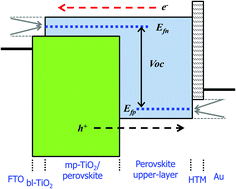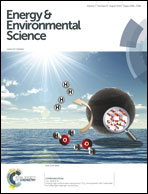Voltage output of efficient perovskite solar cells with high open-circuit voltage and fill factor†
Abstract
Besides the generated photocurrent as a key factor that impacts the efficiency of solar cells, the produced photovoltage and fill factor are also of critical importance. Therefore, understanding and optimization of the open-circuit voltage (Voc) of perovskite solar cells, especially with an architecture consisting of mesoporous (mp)-TiO2/perovskite/hole transporting materials (HTMs), are required to further improve the conversion efficiency. In this work, we study the effects of the energy level between CH3NH3(= MA)PbI3 and MAPbBr3 and a series of triarylamine polymer derivatives containing fluorene and indenofluorene, which have different highest occupied molecular orbital (HOMO) levels, in terms of the photovoltaic behaviour. The voltage output of the device is found to be dependent on the higher energy level of perovskite solar absorbers as well as the HOMO level of the HTMs. The combination of MAPbBr3 and a deep-HOMO HTM leads to a high photovoltage of 1.40 V, with a fill factor of 79% and an energy conversion efficiency of up to 6.7%, which is the highest value reported to date for MAPbBr3 perovskite solar cells.


 Please wait while we load your content...
Please wait while we load your content...